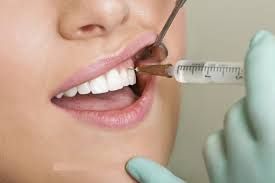Hi Blurtians, today would like to inform dental students among the communities on how to present verbally and demonstrate Local anaesthesia administration in the lower jaw especially for lower premolar and molar teeth.
As it is popularly known, MDCN which is called Medical and Dental Association of Nigeria is a body concerned with the basic assessment of students that study either general medicine or dentistry outside Nigeria. The exam is conducted to check their understanding of the career in question since they were not trained in the country and as such they need to be assessed before they can be allowed to practice in their country and issued license though this is a general in almost everywhere around the globe so it isn't a rare thing.
As for a student to be successful in this assessment exam there are some particular protocols and steps that he/she has to follow in order to get the required marks and clear the exam and that is reason for students to get to those who has the exam before and made it through. I am to list some in this OSCE section of the exam so as to be at least be familiar with the requirements of the examination body.
The required steps are as follows:
1- Greetings and introduction is very important and also the student has to state what he/she is about to demonstrate to the examiner.
For example like this one below:
Good morning sir/ma, my name is "so so". I want to demonstrate and present how to give local anaesthesia to the lower premolar/molar
2- The student should explain the procedure to the patient as well and obtain the patient's consent before doing anything
Here, it is not necessary the patient is present the student just has to do that before the examiner.
3- Furthermore, the students also has to tell the examiner the armamentarium and the required instruments for the procedure which was asked by the examiner. Such as telling the examiner that:
I will need my face mask, sterile gloves, local anaesthesia carpule, short dental needle(in case of infiltration), dental syringe, dental mouth mirror, college tweezers and dental probe.
4- The next thing, is to explain the procedure to the examiner step by step in a proper order and not omitting any important step. Such as saying;
I will sit the patient down on a disinfected dental chair, in semi-upright position, with the height of the head at my elbow level.
I will insert the local anaesthetic cartridge into the dental syringe and attach the long dental needle to the needle adapter of the syringe through the use of the needle hub.
I will first use my thumb to palpate and locate the pterygomandibular raphe on the side to which the local anaesthesia is to be administered. Then I will introduce my needle and syringe from the contralateral side (opposite side) between the first and second premolar, 1cm above the occlusal plane in front of the tip of the thumb finger. I will continue to insert till I touch the bone.
Once I touch the bone with the needle, I pull out the syringe a bit, then aspirate so as to check out that I am not inside a blood vessel, then I deposit or expunge out 2/3 of the cartridge. This will give anaesthesisa to the inferior alveolar nerve and the lingual nerve.
Then I will deposit the remaining 1/3 into the distobuccal area of the last molar present in the mandibular arch so as to give the long buccal nerve in the case molar teeth extraction is required.
After that , I will wait for about 3-4 minutes for the anesthesia to become effective before carrying out my subjective and objective tests.
To know more about objective and subjective test you can check out my previous post on it.
For the subjective test, I will ask the patient if the mouth feels strange sensations or different, what side of the mouth feels different to other part, how it perceives, as well as any strange feelings of the tongue, cheek and lower lip on the side of the mouth that was put to anaesthesisa.
For the objective test, I will ask the patient to maintain or keep the eyes open, then use my dental probe or any blunt instrument to probe or touch the buccal gingival mucosa between the first and second premolar or the teeth that was indicated for extraction. If the patient squint then the anaesthesisa is not yet effective but if the patient doesn't squint the eyelids then it is profound and further procedures could be proceeded.
So that is all as regards demonstration of local anaesthesia administration for the lower premolar and molar.
Thanks for your attention and remain blessed
Reference

Upvoted. Thank You for sending some of your rewards to @null. Read my last post to make sure that BLURT burning is profitable for you. Learn how to get more upvotes
https://blurtlatam.intinte.org/burn/@mariuszkarowski/how-to-get-automatic-upvote-from-my-accounts